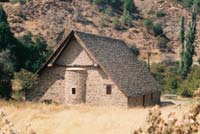 Travelling on the Nicosia-Troodos tourist road and entering the Galata community, in your right you face the "Panagia of Podithou" church. The "Panagia Eleousa" church (Blessed Virgin Mary, the all-merciful), known as "Panagia tis Podithou", is what remained form a small Monastery that today does not exist. The church is built at the centre of a long and narrow valley close to the riverside of Klarios. Travelling on the Nicosia-Troodos tourist road and entering the Galata community, in your right you face the "Panagia of Podithou" church. The "Panagia Eleousa" church (Blessed Virgin Mary, the all-merciful), known as "Panagia tis Podithou", is what remained form a small Monastery that today does not exist. The church is built at the centre of a long and narrow valley close to the riverside of Klarios.
The church's shape is rectangular and -in the east -it ends in a semicircular apse. The internal dimensions without the apse are 12 x 4 meters. It is surrounded by a Š -shaped gallery that is covered by the same V-shaped, wooden roof, which is capped by tile plates made by tile-makers from Galata. It was built in 1502 by Demetrios de Coron and his wife Helen. Demetrios and his family were one of medieval Cyprus's families of Latin descent that were Hellenized. In 1461 Demetrios was the commander in the "Pentagia" region and was in favour of Iacovos, illegitimate brother of the legitimate queen Charlotte, who was illegitimately claiming the royal crown of Cyprus. Forty-one years later, in 1502, Demetrios de Coron built the "Panagia Eleousa" church that was later renamed "Panagia tis Podithou".
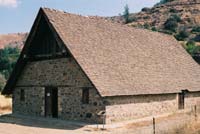 In the external side of the west wall, the Virgin Mary is figured above the central entrance. The donators are depicted under Her throne, a couple to the left and a man to the right, having a model of the church in their midst, which they offer to the Virgin Mary. Under this composition there is the following founder's inscription: In the external side of the west wall, the Virgin Mary is figured above the central entrance. The donators are depicted under Her throne, a couple to the left and a man to the right, having a model of the church in their midst, which they offer to the Virgin Mary. Under this composition there is the following founder's inscription:
"THIS DIVINE AND VENERABLE CHURCH OF THE ALL-HOLY, MERCIFUL MOTHER OF GOD WAS RAISED IN THE YEAR OF OUR CHRIST 1502 THROUGH EXPENSES AND MUCH DESIRE OF KIROU MISER DEMETRI DE CORO AND HIS WIFE ELENI , FOUNDERS OF THIS HOLY MONASTERY AND THOS OF YOU WHO READ THIS PRAY FOR THEM AND WISH THEM HAPPINESS THROUGH OUR LORD, AMEN".
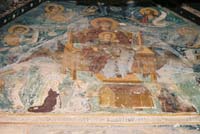 The "Panagia tis Podithou" church was not decorated with frescoes in its entirety. They cover the external side of the west wall, the internal west pediment, the eastern pediment, the quadrant of the apse, and the semicircular wall of the apse.. The Crucifixion in the internal western pediment does not resemble the familiar unadorned Crucifixion of the Byzantine tradition. It is a scene with many characters, influenced by Western painting. It looks more like a religious painting with many details. The Crucified Christ and the thieves, the -westernised -soldiers on horseback, the soldier that is breaking the thieves' legs, the Virgin Mary that tumbles to the ground unconscious, the soldiers that are rolling dice for Christ's tunic and quarrelling, Maria Magdalene embracing the base of Christ's Cross, and -finally -the enigmatic figure of the monk on his knees. The "Panagia tis Podithou" church was not decorated with frescoes in its entirety. They cover the external side of the west wall, the internal west pediment, the eastern pediment, the quadrant of the apse, and the semicircular wall of the apse.. The Crucifixion in the internal western pediment does not resemble the familiar unadorned Crucifixion of the Byzantine tradition. It is a scene with many characters, influenced by Western painting. It looks more like a religious painting with many details. The Crucified Christ and the thieves, the -westernised -soldiers on horseback, the soldier that is breaking the thieves' legs, the Virgin Mary that tumbles to the ground unconscious, the soldiers that are rolling dice for Christ's tunic and quarrelling, Maria Magdalene embracing the base of Christ's Cross, and -finally -the enigmatic figure of the monk on his knees.
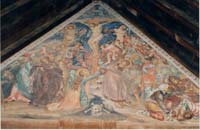 The Holy Towel is pictured at the top of the eastern pediment. The two "visions" of the Prophet Moses are depicted further down. On the left, Moses is receiving the plates with the Ten Commandments from the hands of God. On the right, Moses is bending down so as to untie the lace of his sandal. Before him and higher above there is a depiction of the Virgin Mary with Christ in an "engkolpio" (shape of a handbook), in the midst of the Burning Bush's flames. The Holy Towel is pictured at the top of the eastern pediment. The two "visions" of the Prophet Moses are depicted further down. On the left, Moses is receiving the plates with the Ten Commandments from the hands of God. On the right, Moses is bending down so as to untie the lace of his sandal. Before him and higher above there is a depiction of the Virgin Mary with Christ in an "engkolpio" (shape of a handbook), in the midst of the Burning Bush's flames.
In the apse's quadrant and in a majestic composition, the Virgin Mary is depicted enthroned and having Christ on her knees while the archangels Michael and Gabriel are turned toward the Virgin Mary, holding candles and admiring her.
This fresco, which is preserved in good condition, is very impressive.
"…It is perfect in composition, very beautiful in appearance, and quite rich in internal reflection, worked with delicacy and grace, craftsmanship and studiousness, and with clarity of perception…"
(Cyprian Studies)
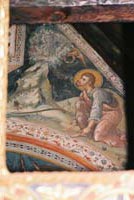 Under this wonderful -oval shaped - "baby-holding" Virgin Mary, there is a depiction of the Apostles' Holy Communion in two scenes. On the left there's the sharing of the "Artos" (Holy Bread) and on the right the receiving of the "Enos" (Wine). Then come the following Hagiographies from the Old Testament, which are mentioned amongst the Apocrypha (secret, non-canonical gospels) of St Jacob. Joachim and Anna offering the gifts, the Prayer of Joachim, the Prayer of St. Anna, the embrace of Joachim and Anna, the Birth of the Virgin Mary. Under this wonderful -oval shaped - "baby-holding" Virgin Mary, there is a depiction of the Apostles' Holy Communion in two scenes. On the left there's the sharing of the "Artos" (Holy Bread) and on the right the receiving of the "Enos" (Wine). Then come the following Hagiographies from the Old Testament, which are mentioned amongst the Apocrypha (secret, non-canonical gospels) of St Jacob. Joachim and Anna offering the gifts, the Prayer of Joachim, the Prayer of St. Anna, the embrace of Joachim and Anna, the Birth of the Virgin Mary.
The church's icon screen is considered as one of the best woodcut, gild-edged icon screens of the 16 th century. Unfortunately, neither the Cross up above nor the small icons high up the icon screen are in existence. The Bema Doors of the temple, works of art with great value, have been stolen in the beginning of 2003 and their whereabouts are unknown.
The name "Podithou" or "Podythou".
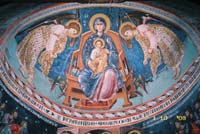 The centre of the entire hagiography in the "Panagia tis Podithou" church is the Enthroned Virgin Mary Holding the Infant Christ in the apse of the Holy Bema. The positioning of the Burning Bush at the highest point of the temple is an innovation emphasising the "Vision" of Moses. The centre of the entire hagiography in the "Panagia tis Podithou" church is the Enthroned Virgin Mary Holding the Infant Christ in the apse of the Holy Bema. The positioning of the Burning Bush at the highest point of the temple is an innovation emphasising the "Vision" of Moses.
"Untie the shoes from your feet" said God to Moses when he stood before the Burning Bush in Mount Horeb, " Apodithou ta ipodimata sou" (in Greek, remove your footwear), the priests and preachers would explain to the faithful, analysing the words of God toward Moses. Thus the name "Panagia tis Podythou" (Virgin Mary of Podythou) or "Po'ythou" in the dialect of the people until today.
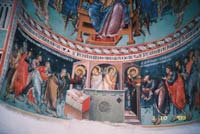 In the south-east of the church there was the two-level house, the ground level of which was known as the "School of the Podithou Monastery". Unfortunately it was demolished in 1950. In the south-east of the church there was the two-level house, the ground level of which was known as the "School of the Podithou Monastery". Unfortunately it was demolished in 1950.
In 1735 the Russian traveller Vasilios Barsky refers to the monastery of "Podithou", which he visited. "It ha a small church covered in tiles…" He mentions the harsh and miserable conditions under which the two monks live because of the Moslems, which grab by force foods and drinks.
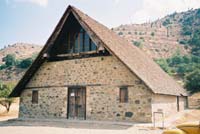 UNESCO has included the church of "Panagia Podithou" amongst the 10 Byzantine churches of Cyprus that were deemed to be of particular importance and were included in the list of World cultural heritage. UNESCO has included the church of "Panagia Podithou" amongst the 10 Byzantine churches of Cyprus that were deemed to be of particular importance and were included in the list of World cultural heritage.
This is recorder at the entrance:
PANAGIA TIS PODITHOU
UNESCO
WORLD CULTURAL HERITAGE |